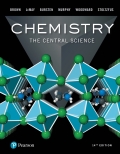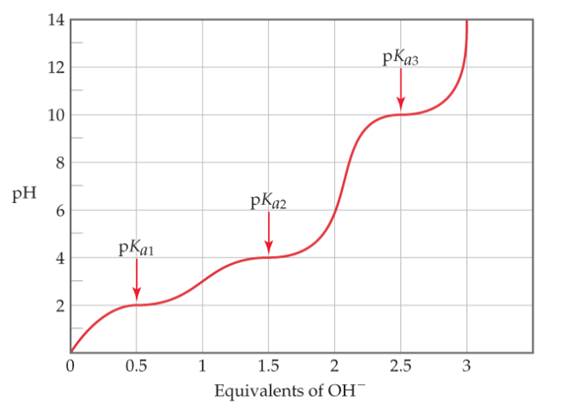
EBK CHEMISTRY:CENTRAL SCIENCE
14th Edition
ISBN: 9780134554570
Author: Brown
Publisher: PEARSON
expand_more
expand_more
format_list_bulleted
Concept explainers
Textbook Question
Chapter 24, Problem 100IE
A typical amino acid with one amino group and one
- Suggest the forms of the amino acid at low PH and at high pH.
- Amino acids generally have two pKa values, one in the range of 2 to 3 and the other in the range of 9 to 10. Serine, for example, has pKa values of 2.19 and 9.21. Using species such as acetic acid and ammonia as models, suggest the origin of the two pKa values.
- Glutamic acid is an amino acid that has three pKa’s: 2.10, 4.07, and 9.47. Draw the structure of glutamic acid, and assign each pKa to the appropriate part of the molecule.
- An unknown amino acid is titrated with strong base, producing the following titration curve. Which amino acids are likely candidates for the unknown?

Expert Solution & Answer
Want to see the full answer?
Check out a sample textbook solution
Students have asked these similar questions
Draw the skeletal structure of the
alkane 4-ethyl-2, 2, 5, 5-
tetramethylnonane. How many
primary, secondary, tertiary, and
quantenary carbons does it have?
Don't used Ai solution
Don't used Ai solution
Chapter 24 Solutions
EBK CHEMISTRY:CENTRAL SCIENCE
Ch. 24.2 - Prob. 24.1.1PECh. 24.2 - Prob. 24.1.2PECh. 24.2 - How many hydrogen atoms are in 2, 2-...Ch. 24.2 - Prob. 24.2.2PECh. 24.3 - Prob. 24.3.1PECh. 24.3 - Prob. 24.3.2PECh. 24.3 - Prob. 24.4.1PECh. 24.3 - Prob. 24.4.2PECh. 24.3 - Prob. 24.5.1PECh. 24.3 - Prob. 24.5.2PE
Ch. 24.4 - Prob. 24.6.1PECh. 24.4 - Prob. 24.6.2PECh. 24.7 - Prob. 24.7.1PECh. 24.7 - Practice Exercise 2 Name the dipeptide and give...Ch. 24.7 - How many chiral carbon atoms are there in the...Ch. 24.7 - Prob. 24.8.2PECh. 24 - Prob. 1DECh. 24 - Prob. 1ECh. 24 - Prob. 2ECh. 24 - Prob. 3ECh. 24 - Prob. 4ECh. 24 - Prob. 5ECh. 24 - Prob. 6ECh. 24 - Prob. 7ECh. 24 - Prob. 8ECh. 24 - Prob. 9ECh. 24 - Prob. 10ECh. 24 - Prob. 11ECh. 24 - Prob. 12ECh. 24 - Prob. 13ECh. 24 - Prob. 14ECh. 24 - Prob. 15ECh. 24 - Prob. 16ECh. 24 - Prob. 17ECh. 24 - Prob. 18ECh. 24 - Prob. 19ECh. 24 - Prob. 20ECh. 24 - Prob. 21ECh. 24 - Prob. 22ECh. 24 - Prob. 23ECh. 24 - Prob. 24ECh. 24 - Prob. 25ECh. 24 - Prob. 26ECh. 24 - Prob. 27ECh. 24 - Prob. 28ECh. 24 - Prob. 29ECh. 24 - Prob. 30ECh. 24 - Prob. 31ECh. 24 - Prob. 32ECh. 24 - Prob. 33ECh. 24 - Prob. 34ECh. 24 - Prob. 35ECh. 24 - Prob. 36ECh. 24 - Prob. 37ECh. 24 - Prob. 38ECh. 24 - Prob. 39ECh. 24 - Describe the intermediate that is thought to form...Ch. 24 - Prob. 41ECh. 24 - Prob. 42ECh. 24 - Prob. 43ECh. 24 - Prob. 44ECh. 24 - Prob. 45ECh. 24 - Prob. 46ECh. 24 - Prob. 47ECh. 24 - Prob. 48ECh. 24 - Prob. 49ECh. 24 - Prob. 50ECh. 24 - Prob. 51ECh. 24 - Prob. 52ECh. 24 - Prob. 53ECh. 24 - Prob. 54ECh. 24 - Prob. 55ECh. 24 - Prob. 56ECh. 24 - Prob. 57ECh. 24 - Prob. 58ECh. 24 - Prob. 59ECh. 24 - Prob. 60ECh. 24 - Prob. 61ECh. 24 - Prob. 62ECh. 24 - Prob. 63ECh. 24 - Prob. 64ECh. 24 - Prob. 65ECh. 24 - Prob. 66ECh. 24 - Prob. 67ECh. 24 - Prob. 68ECh. 24 - Prob. 69ECh. 24 - Prob. 70ECh. 24 - Prob. 71ECh. 24 - Prob. 72ECh. 24 - Prob. 73ECh. 24 - Prob. 74ECh. 24 - Prob. 75ECh. 24 - Prob. 76ECh. 24 - Prob. 77ECh. 24 - Prob. 78ECh. 24 - Prob. 79ECh. 24 - Prob. 80ECh. 24 - Prob. 81AECh. 24 - Prob. 82AECh. 24 - Prob. 83AECh. 24 - Prob. 84AECh. 24 - Prob. 85AECh. 24 - Prob. 86AECh. 24 - Prob. 87AECh. 24 - Prob. 88AECh. 24 - Prob. 89AECh. 24 - Prob. 90AECh. 24 - Prob. 91AECh. 24 - Prob. 92AECh. 24 - Prob. 93AECh. 24 - Prob. 94AECh. 24 - Prob. 95IECh. 24 - Prob. 96IECh. 24 - Prob. 97IECh. 24 - Prob. 98IECh. 24 - Prob. 99IECh. 24 - A typical amino acid with one amino group and one...Ch. 24 - Prob. 101IECh. 24 - Prob. 102IE
Knowledge Booster
Learn more about
Need a deep-dive on the concept behind this application? Look no further. Learn more about this topic, chemistry and related others by exploring similar questions and additional content below.Similar questions
- The number of imaginary replicas of a system of N particlesA) can never become infiniteB) can become infiniteC) cannot be greater than Avogadro's numberD) is always greater than Avogadro's number.arrow_forwardElectronic contribution to the heat capacity at constant volume A) is always zero B) is zero, except for excited levels whose energy is comparable to KT C) equals 3/2 Nk D) equals Nk exp(BE)arrow_forwardPlease correct answer and don't used hand raitingarrow_forward
- Calculate the packing factor of CaTiO3. It has a perovskite structure. Data: ionic radii Co²+ = 0.106 nm, Ti4+ = 0.064 nm, O² = 0.132 nm; lattice constant is a = 2(rTi4+ + ro2-). Ca2+ 02- T14+ Consider the ions as rigid spheres. 1. 0.581 or 58.1% 2. -0.581 or -58.1 % 3. 0.254 or 25.4%arrow_forwardGeneral formula etherarrow_forwardPlease provide the retrosynthetic analysis and forward synthesis of the molecule on the left from the starting material on the right. Please include hand-drawn structures! will upvote! Please correct answer and don't used hand raitingarrow_forward
- Please provide the retrosynthetic analysis and forward synthesis of the molecule on the left from the starting material on the right. Please include hand-drawn structures! will upvote!arrow_forward(please correct answer and don't used hand raiting) Please provide the retrosynthetic analysis and forward synthesis of the molecule on the left from the starting material on the right. Please include hand-drawn structures! will upvote!arrow_forwardCaTiO3 has a perovskite structure. Calculate the packing factor.Data: ionic radii Co+2 = 0.106 nm, Ti+4 = 0.064 nm, O-2 = 0.132 nm; lattice constant is a = 2(rTi4+ + rO-2).(a) 0.581(b) -0.581(c) 0.254(d) -0.254arrow_forward
- In the initial linear section of the stress-strain curve of a metal or alloy. Explain from the point of view of atomic structure?(a) No, the atomic level properties of the material can never be related to the linear section.(b) The elastic zone is influenced by the strength of the bonds between atoms.(c) The stronger the bond, the less rigid and the lower the Young's Modulus of the material tested.(d) The stronger the bond, the less stress is necessary to apply to the material to deform it elastically.arrow_forwardThe degree of polymerization of polytetrafluoroethylene (Teflon) is 7500 (mers/mol). If all polymer chains have equal length, state the molecular weight of the polymer and the total number of chains in 1000 g of the polymer(a) 50 000 g/mol; 0.03·1020 chains(b) 100 000 g/mol; 1.03·1020 chains(c) 750 000 g/mol; 8.03·1020 chainsarrow_forwardIn natural rubber or polyisoprene, the trans isomer leads to a higher degree of crystallinity and density than the cis isomer of the same polymer, because(a) it is more symmetrical and regular.(b) it is less symmetrical.(c) it is irregular.arrow_forward
arrow_back_ios
SEE MORE QUESTIONS
arrow_forward_ios
Recommended textbooks for you
 World of ChemistryChemistryISBN:9780618562763Author:Steven S. ZumdahlPublisher:Houghton Mifflin College Div
World of ChemistryChemistryISBN:9780618562763Author:Steven S. ZumdahlPublisher:Houghton Mifflin College Div Introduction to General, Organic and BiochemistryChemistryISBN:9781285869759Author:Frederick A. Bettelheim, William H. Brown, Mary K. Campbell, Shawn O. Farrell, Omar TorresPublisher:Cengage Learning
Introduction to General, Organic and BiochemistryChemistryISBN:9781285869759Author:Frederick A. Bettelheim, William H. Brown, Mary K. Campbell, Shawn O. Farrell, Omar TorresPublisher:Cengage Learning Chemistry for Today: General, Organic, and Bioche...ChemistryISBN:9781305960060Author:Spencer L. Seager, Michael R. Slabaugh, Maren S. HansenPublisher:Cengage Learning
Chemistry for Today: General, Organic, and Bioche...ChemistryISBN:9781305960060Author:Spencer L. Seager, Michael R. Slabaugh, Maren S. HansenPublisher:Cengage Learning Principles of Modern ChemistryChemistryISBN:9781305079113Author:David W. Oxtoby, H. Pat Gillis, Laurie J. ButlerPublisher:Cengage Learning
Principles of Modern ChemistryChemistryISBN:9781305079113Author:David W. Oxtoby, H. Pat Gillis, Laurie J. ButlerPublisher:Cengage Learning

World of Chemistry
Chemistry
ISBN:9780618562763
Author:Steven S. Zumdahl
Publisher:Houghton Mifflin College Div

Introduction to General, Organic and Biochemistry
Chemistry
ISBN:9781285869759
Author:Frederick A. Bettelheim, William H. Brown, Mary K. Campbell, Shawn O. Farrell, Omar Torres
Publisher:Cengage Learning


Chemistry for Today: General, Organic, and Bioche...
Chemistry
ISBN:9781305960060
Author:Spencer L. Seager, Michael R. Slabaugh, Maren S. Hansen
Publisher:Cengage Learning

Principles of Modern Chemistry
Chemistry
ISBN:9781305079113
Author:David W. Oxtoby, H. Pat Gillis, Laurie J. Butler
Publisher:Cengage Learning
Biomolecules - Protein - Amino acids; Author: Tutorials Point (India) Ltd.;https://www.youtube.com/watch?v=ySNVPDHJ0ek;License: Standard YouTube License, CC-BY